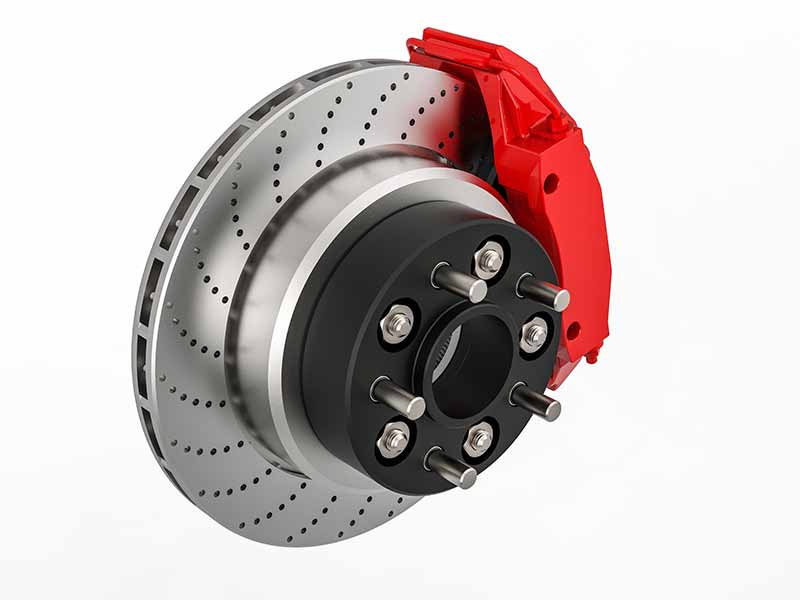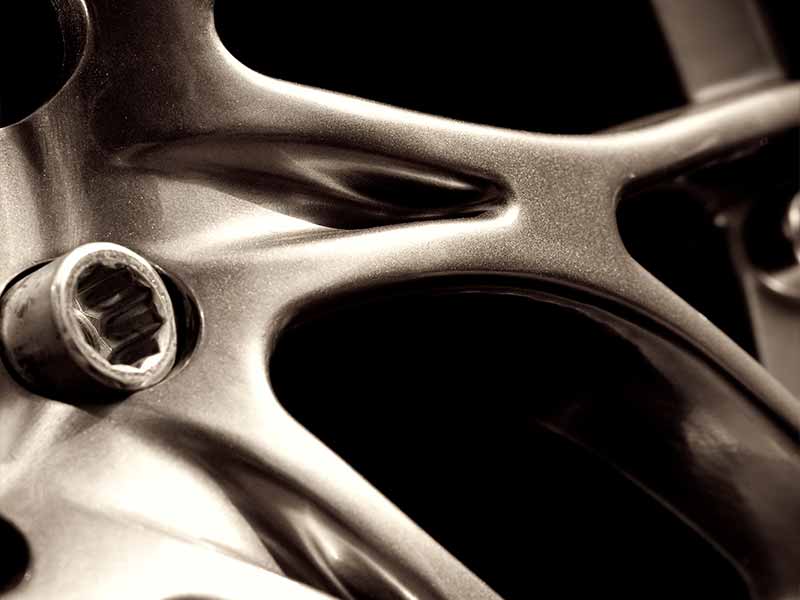Bolt patterns are crucial for ensuring proper wheel fitment on your vehicle, contributing to safe and stable driving. They also guide you in purchasing compatible wheels or tires, preventing costly and potentially dangerous mismatching.
How To Measure Bolt Pattern
Bolt patterns are usually measured from the center of one wheel stud or bolt hole to the opposite stud or bolt hole. This works for 4, 6, and 8-lug bolt patterns.
5-lug bolt patterns require measuring from the center of one stud or bolt hole to the back of the nearest opposite stud or bolt hole.
In this article, we’ll guide you through the basics of bolt patterns, teach you how to measure different lug patterns, help you understand what a dual-drill bolt pattern is, and show you how to use a bolt pattern conversion chart. We’ll even answer the burning question: Can you actually change your bolt pattern?
Let’s take a closer look.
Basics Of A Bolt Pattern
A bolt pattern, also called a lug pattern or a bolt circle, is a series of holes in the center of your wheel. It’s where the wheel attaches to your vehicle. This pattern is defined by two key parts:
- The Number of Lugs: These are the bolts or studs sticking out from your car or truck’s hub (the central part of your wheel). They can range from four up to eight for most passenger vehicles and trucks.
- The Diameter of the Circle: This one’s a little tricky, but stay with me. Imagine a perfect circle running through the middle of each lug. The diameter of that imaginary circle is the second part of our bolt pattern.
So, if you hear someone talking about a ‘5 on 4.5’ bolt pattern, they mean there are five lugs, and the diameter of the circle passing through the lugs is 4.5 inches.
It’s essential to know your vehicle’s bolt pattern for many reasons, like:
- Wheel Compatibility: If you’re thinking about getting shiny new wheels for your ride, you need to make sure their bolt pattern matches your vehicle’s. No matching bolt pattern, no fitting wheels!
- Safety: Wheels that don’t fit your bolt pattern could lead to unstable and unsafe driving conditions. It’s like trying to wear shoes three sizes too big!
- Vehicle Performance: The right bolt pattern ensures your wheels fit snuggly, reducing vibration, and improving your vehicle’s overall performance.
Guide To Measuring Bolt Patterns
Now that we’ve covered what a bolt pattern is and where to find it on your rims, it’s time to get down to the nitty-gritty – measuring those bolt patterns. Grab your measuring tape and let’s get to it!
Before we start, here are a couple of things you’ll need:
- A measuring tape (or a bolt pattern gauge if you have one)
- A little bit of patience (trust me, it’s worth it)
Measuring A 4-Lug Bolt Pattern
This one’s as easy as pie! You’re simply going to measure from the center of one lug to the center of the lug directly across from it. This is your diameter. Simple, right?
Common 4-Lug Patterns
There are a few common ones you’ll usually come across. These are often found on compact cars, small sedans, or classic vehicles. Here they are:
- 4x100mm: This bolt pattern is pretty common, especially for smaller cars. Manufacturers that commonly use this pattern include Honda, Toyota, VW, BMW (on their smaller cars), and more.
- 4×114.3mm (or 4×4.5 inches): This bolt pattern is another commonly seen one. You’ll find this on some models from Nissan, Mitsubishi, and older American vehicles.
- 4x108mm (or 4×4.25 inches): This bolt pattern is often found on some European cars, such as older models of Audi and Ford.
- 4x98mm: This bolt pattern is a bit less common but can be found on some models from Fiat, Alfa Romeo, and Lancia.
Measuring A 5-Lug Bolt Pattern
Now, this is where it gets a bit trickier, folks. For a 5-lug pattern, you can’t measure from lug to lug directly since none are directly opposite each other. Instead, measure from the center of one lug to the back of the lug furthest away from it. This will give you your bolt pattern diameter.
Common 5-Lug Patterns
There are a variety of common patterns you might encounter. These are frequently found on midsize cars, SUVs, and light trucks. Here are some of the most common ones:
- 5x100mm: You’ll commonly see this bolt pattern on smaller cars and sedans like certain models from Subaru, VW, and Toyota.
- 5×114.3mm (or 5×4.5 inches): This is one of the most common bolt patterns out there. Many manufacturers, from Honda and Toyota to Ford and Hyundai, use this pattern on a variety of vehicles.
- 5x120mm: You’ll commonly find this bolt pattern on larger sedans, SUVs, and trucks. Manufacturers using this pattern include BMW, some Chevy models, and Honda’s Ridgeline and Pilot models.
- 5x127mm (or 5×5 inches): This bolt pattern is commonly found on larger vehicles like full-size SUVs and trucks. Manufacturers like Jeep, Chevrolet, and GMC often use this pattern.
- 5×139.7mm (or 5×5.5 inches): This is common on larger trucks and SUVs. You’ll often see this bolt pattern on vehicles like older Ford F-150s, Dodge Rams, and some Suzuki models.
Measuring A 6-Lug Bolt Pattern
For a 6-lug pattern, it’s back to basics! Just like the 4-lug, you measure from the center of one lug directly across to the center of another.
Common 6-Lug Patterns
These are typically found on larger vehicles like full-sized trucks and SUVs. Here are some of the most common ones:
- 6×114.3mm: This bolt pattern is commonly found on certain models from Nissan and Mitsubishi.
- 6x127mm (or 6×5 inches): This bolt pattern is used in some larger SUVs. You might find it on certain models from Chevrolet and GMC.
- 6x135mm: This bolt pattern is common on many newer Ford trucks, such as certain models of the Ford F-150.
- 6×139.7mm (or 6×5.5 inches): This is a very common 6-lug pattern. You’ll find this on many trucks and SUVs, from manufacturers like Chevrolet, GMC, Toyota, and Nissan.
Measuring An 8-Lug Bolt Pattern
Just like the 4 and 6-lug patterns, you’ll measure from the center of one lug to the center of a lug directly across the wheel.
Common 8-Lug Patterns
When it comes to 8-lug bolt patterns, you’re typically looking at heavier-duty vehicles like larger trucks and commercial vehicles. These are some of the most common ones you might encounter:
- 8×165.1mm (or 8×6.5 inches): This is a common bolt pattern for older heavy-duty trucks. You might find it on certain models from Chevrolet, GMC, Dodge, and Ram.
- 8x170mm: This bolt pattern is typically found on Ford’s F-250 and F-350 models, among other heavy-duty trucks.
- 8x180mm: This is a newer bolt pattern used on some later-model GM and Chevrolet heavy-duty trucks.
- 8x200mm: This bolt pattern is commonly found on the Ford F-450 and F-550 Super Duty Trucks.
Remember, accuracy is the key here. A small mistake in measuring can lead to the wrong wheel fitment, and that’s a road we don’t want to go down. So take your time, double-check your measurements, and you’ll be golden.
Also, a quick tip for you – if you’re planning to upgrade your wheels frequently or if you run a workshop, consider investing in a bolt pattern gauge. They make the job faster and a lot easier!
Understanding Dual-Drill Bolt Patterns
A dual-drill bolt pattern means the wheel has two different sets of holes for the lugs. Think of it like having two different faces. One moment it’s saying, “I can fit a 5-lug pattern,” and the next, it’s like, “But I can also fit a 4-lug pattern.”

Duall-Drill Bolt Pattern Wheel
Here are some things you might want to know about dual-drill bolt patterns:
- Versatility: Dual-drill wheels are like the chameleons of the wheel world. They can adapt to two different types of bolt patterns, making them super versatile. If you’re into swapping wheels often, these could be your best friends!
- Resale Value: Thanks to their versatility, dual-drill wheels tend to have higher resale values. After all, they can fit more types of vehicles.
- Installation: When installing dual-drill wheels, be careful to line up the correct bolt pattern with your vehicle’s lugs. Remember, just because it can fit two patterns doesn’t mean both will fit your ride!
Before you rush off to buy dual-drill wheels, there’s something you should know:
- Potential Weakness: More holes mean more potential points of weakness. While it’s not always an issue, it’s something to be aware of, especially if you’re into off-roading or other high-stress driving conditions.
Bolt Pattern Conversion Chart
A bolt pattern conversion chart helps us translate bolt patterns from one measuring system to another – typically from inches to millimeters. Why, you ask? Well, some wheel manufacturers use inches, while others prefer millimeters.
| Lug Count | Bolt Pattern (Metric) | Bolt Pattern (Imperial) |
|---|---|---|
| 4 Lug | 4x100mm | 4×3.94″ |
| 4x108mm | 4×4.25″ | |
| 4×114.3mm | 4×4.5″ | |
| 4x98mm | 4×3.86″ | |
| 5 Lug | 5x100mm | 5×3.94″ |
| 5×114.3mm | 5×4.5″ | |
| 5x120mm | 5×4.72″ | |
| 5x127mm | 5×5″ | |
| 6 Lug | 6×114.3mm | 6×4.5″ |
| 6x127mm | 6×5″ | |
| 6x135mm | 6×5.31″ | |
| 6×139.7mm | 6×5.5″ | |
| 8 Lug | 8×165.1mm | 8×6.5″ |
| 8x170mm | 8×6.69″ | |
| 8x180mm | 8×7.09″ | |
| 8x200mm | 8×7.87″ |
Keep in mind, though, conversion charts can only guide you with the diameter of the bolt pattern. They can’t help with the number of lugs. That part doesn’t change, no matter what measurement system you’re using.
Always double-check your conversions, especially before making any purchases.
Changing Bolt Patterns: Is It Possible?
Yes, technically, you can change your bolt pattern. This is usually done using something called a wheel adapter. These adapters attach to your vehicle’s hub, giving you a new bolt pattern to work with.

However, before you rush off to change your bolt pattern, there are a few important things to consider:
- Safety: Changing the bolt pattern could affect your vehicle’s balance and alignment, which can lead to unsafe driving conditions. Safety first, folks!
- Vehicle Stress: Using adapters can put additional stress on your vehicle’s suspension and braking systems. This might cause these parts to wear out faster than normal.
- Legalities: In some areas, altering your bolt pattern might not be legal, so check with local regulations before making any changes.
- Professional Installation: If you do decide to change your bolt pattern, it’s crucial to have a professional do the job. This isn’t the time for DIY, trust me!
In short, while you can change your bolt pattern, it’s not usually recommended unless absolutely necessary. It’s always best to find wheels that match your existing bolt pattern. They’ll fit better, run smoother, and be safer in the long run.
Resources
Below are some links you may find helpful when learning about tires
Final Thoughts
You can now measure bolt patterns like a pro, understand the unique characteristics of 4, 5, 6, and even 8-lug patterns, and know the ins and outs of dual-drill bolt patterns. And who could forget the handy bolt pattern conversion chart, your new translator in the wheel world!
Understanding your vehicle’s bolt pattern is more than just a fun fact – it’s crucial to maintaining the safety and functionality of your ride. A right bolt pattern ensures proper wheel fitment and contributes to a smoother, safer journey.
Good luck and happy motoring.





